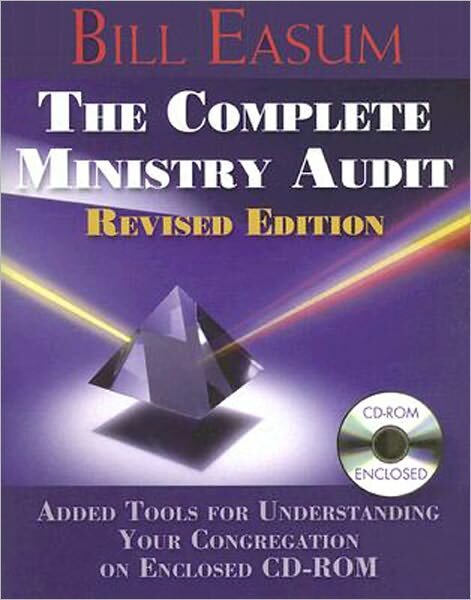Bill Easum and Robert Brydia, The Complete Ministry Audit, Revised Edition. Abingdon Press, 2006.
Referenced in: Strategies for Congregational Renewal: Diagnostic/Prescriptive
LifeandLeadership.com Summary
Bill Easum published the first volume in 1996 under the title, The Complete Ministry Audit: How To Measure 20 Principles for Growth. It was intended to go alongside The Church Growth Handbook (1990) which described the twenty growth principles that provide the basis for the diagnostic procedures in The Complete Ministry Audit. These companion volumes enjoyed wide use and popularity among both evangelicals and mainlines denominations. The revised edition updates the original in several areas based on Easum’s experience as a consultant. It is still based on the twenty growth principles that address four main areas of congregational life. One would not necessarily need the older companion volume, The Church Growth Handbook, to understand the growth principles, as the first half of The Complete Ministries Audit covers them adequately. These principles are discussed in the first half of the book:
- Growth Principles 1-6: Meeting People’s Needs – suggests understanding the needs and preferences of members, providing a balanced ministry that gives people choices among multiple options, matching people with skills, preventing inactive members, providing a wider outreach, and participating in the public arena.
- Growth Principles 7-11: Worship, Leadership, and Ability – suggests emphasizing relevant worship, adding a worship service, valuing the leadership strength of the pastor and a growth-oriented attitude among the pastor and staff, and thinking clearly about your congregation’s size and ability.
- Growth Principles 12-16: Space, Distance, and Visitors – suggests providing plenty of space and adequate parking, deciding about future building plans, seeking nontransfer growth, being friendly toward visitors, and
- Growth Principles 17-20: Money, Planning, and Change – suggests not being afraid to ask for money, laying a solid foundation through statements of mission/vision/values, planning strategically, and being ready to work hard and make changes.
The second half of the book presents the actual survey mechanisms, including worksheets to create readiness among the staff and official body (e.g. elders, board), and then the Complete Ministry Audit worksheets to assess the congregation’s status with respect the twenty growth principles.
This is a staff/board driven model, and is highly prescriptive, in that it suggests where a church should be ideally in each of the twenty areas. If one accepts these twenty principles as good benchmarks (strongly tied to Church Growth philosophy), Easum is a good model. One might argue that the twenty principles need updating, as they were first derived in the late 80s-90s. This may be the case depending on one’s context and philosophy of ministry. Given the fact that most churches are at least a decade behind the cultural curve, many churches would still experience The Complete Ministry Audit as a significant stretch beyond their current status. Like most other diagnostic tools, one may glean helpful insights from this and other approaches to develop their own hybrid model.
Easum emphasizes permission-giving, servant-empowering belief systems and structures that unleash the church into gift-based ministry. He also strongly recommends multi-track worship assemblies, with at least one strongly contemporary service. Even if one does not use all of his model (e.g. not all growth-oriented churches will share Bandy’s assumptions about worship), any established church in a serious assessment mode would benefit from perusing his writings.
An often recommended companion to this updated edition is Easum’s Unfreezing Moves, which presents the key principles related to the implementation of the Complete Ministry Audit. Some also find good cross-pollination with other volumes by Bill Easum and Thom Bandy that are featured in the resource guide on Easum and Bandy’s Diagnostic Methods.
From the Publisher
The essential tool for gauging your congregation’s health and potential for growth. Bill Easum’s The Complete Ministry Audit has long enabled congregations to understand what their particular character is, diagnose their problems and opportunities, and plot strategies to remedy problems and extend their mission into the community. Essentially a condensed version of the instrument Easum himself employs in a consultation, it uses congregational surveys and questionnaires to give church leaders the best tools they can get for plotting their congregation’s course. This revised edition makes The Complete Ministry Audit even more user friendly, with updated questionnaires, new guides to interpreting the data, and more comprehensive electronic tools on the enclosed CD-ROM. The survey section contains the surveys that you will use to prepare the audit. The surveys are as follows: Worship Survey, Staff Survey, Staff Readiness Survey, Staff Permission Giving Survey, Official Body Survey, Official Body Readiness Survey, and the Official Body Permission Giving Survey.
About the Author
Bill Easum is Senior Consultant with 21st Century Strategies and is one of the most highly respected church consultants and Christian futurists in North America. Bill has been a pioneer in the church growth movement, with 35 years of pastoral ministry in four churches and two denominations. During his 24 years at Colonial Hills Church in San Antonio, the church grew from 35 in worship to over 1,000, with 2,200 members. His record of evangelization and social justice ministries has been acknowledged by the Industrial Areas Foundation in New York as one of the finest records in North America. Bill is a graduate of Baylor University, B.A., Southwestern Baptist Theological Seminary, M.D., and Perkins School of Theology, S.T.M. Bill and his wife Jan have one daughter, Caran. Bill’s main vice is he loves to salt water fish and then let the fish go.
***For additional information on this resource, including reviews, click the bookstore links. Check the reference at page top or the links below for resource guides on related topics.***
See Resources on Over 100 Areas of Ministry Leadership:


